Creativity, Innovation and Design Thinking Essay: BUS101 Module
VerifiedAdded on 2022/08/13
|10
|2823
|46
Essay
AI Summary
This essay critically analyzes the concepts of creativity, innovation, and design thinking within the modern business environment, arguing that organizations play a crucial role in fostering these processes, rather than solely relying on individual employees. The essay defines these concepts and explores the influence of organizational culture, leadership practices, and workforce diversity on employee usage. Using real-world examples of Tesla, Starbucks, and Apple, the essay demonstrates how these corporations actively cultivate environments that encourage innovation, creativity, and design thinking. The arguments are supported by various theories and models, including the innovative value chain, cognitive diversity hypothesis, and transformational leadership model. The essay concludes that organizational factors significantly impact the application of these concepts, influencing overall business performance and competitive advantage. This assignment highlights the importance of strategic organizational approaches in driving creativity, innovation, and design thinking within the workforce.
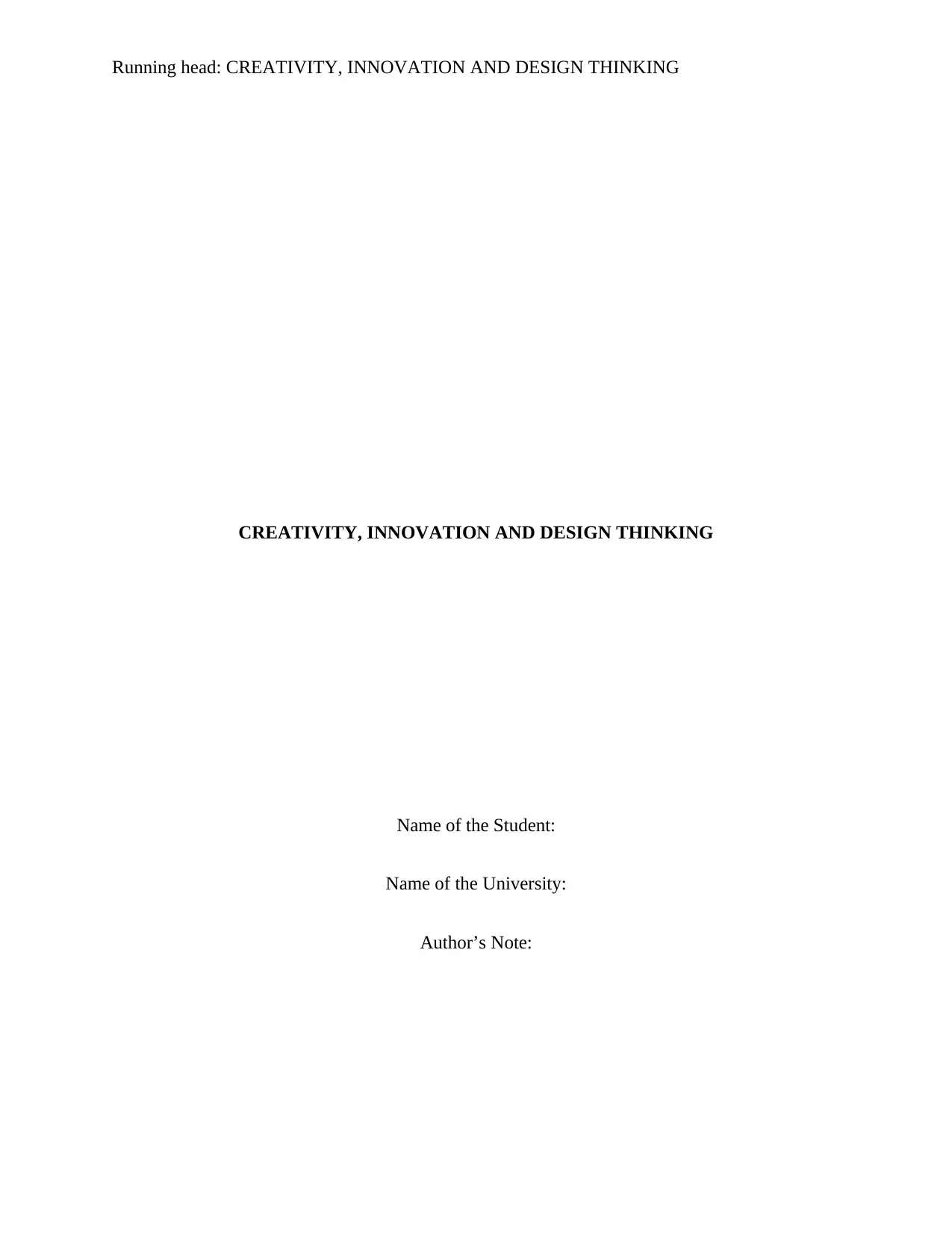
Running head: CREATIVITY, INNOVATION AND DESIGN THINKING
CREATIVITY, INNOVATION AND DESIGN THINKING
Name of the Student:
Name of the University:
Author’s Note:
CREATIVITY, INNOVATION AND DESIGN THINKING
Name of the Student:
Name of the University:
Author’s Note:
Paraphrase This Document
Need a fresh take? Get an instant paraphrase of this document with our AI Paraphraser
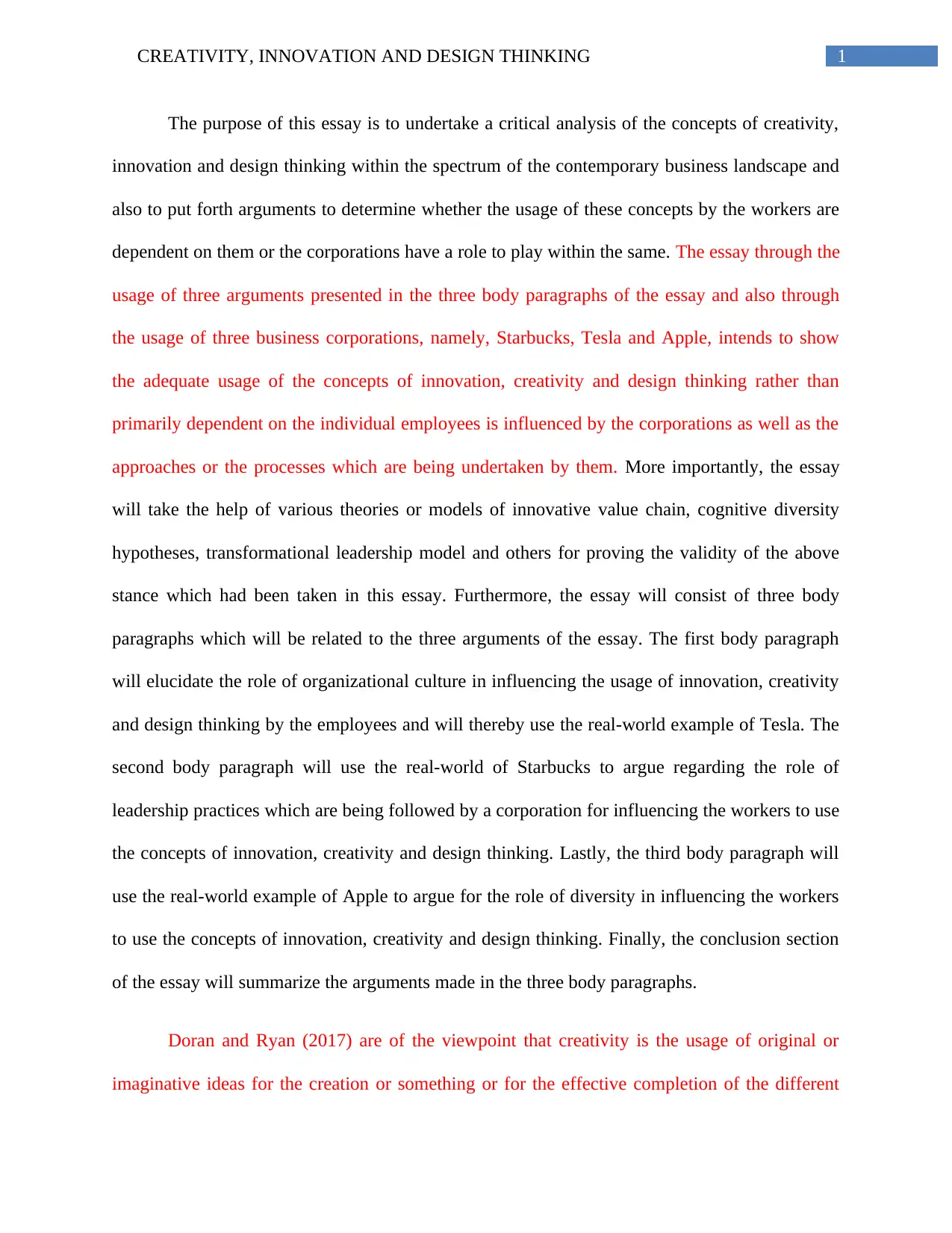
1CREATIVITY, INNOVATION AND DESIGN THINKING
The purpose of this essay is to undertake a critical analysis of the concepts of creativity,
innovation and design thinking within the spectrum of the contemporary business landscape and
also to put forth arguments to determine whether the usage of these concepts by the workers are
dependent on them or the corporations have a role to play within the same. The essay through the
usage of three arguments presented in the three body paragraphs of the essay and also through
the usage of three business corporations, namely, Starbucks, Tesla and Apple, intends to show
the adequate usage of the concepts of innovation, creativity and design thinking rather than
primarily dependent on the individual employees is influenced by the corporations as well as the
approaches or the processes which are being undertaken by them. More importantly, the essay
will take the help of various theories or models of innovative value chain, cognitive diversity
hypotheses, transformational leadership model and others for proving the validity of the above
stance which had been taken in this essay. Furthermore, the essay will consist of three body
paragraphs which will be related to the three arguments of the essay. The first body paragraph
will elucidate the role of organizational culture in influencing the usage of innovation, creativity
and design thinking by the employees and will thereby use the real-world example of Tesla. The
second body paragraph will use the real-world of Starbucks to argue regarding the role of
leadership practices which are being followed by a corporation for influencing the workers to use
the concepts of innovation, creativity and design thinking. Lastly, the third body paragraph will
use the real-world example of Apple to argue for the role of diversity in influencing the workers
to use the concepts of innovation, creativity and design thinking. Finally, the conclusion section
of the essay will summarize the arguments made in the three body paragraphs.
Doran and Ryan (2017) are of the viewpoint that creativity is the usage of original or
imaginative ideas for the creation or something or for the effective completion of the different
The purpose of this essay is to undertake a critical analysis of the concepts of creativity,
innovation and design thinking within the spectrum of the contemporary business landscape and
also to put forth arguments to determine whether the usage of these concepts by the workers are
dependent on them or the corporations have a role to play within the same. The essay through the
usage of three arguments presented in the three body paragraphs of the essay and also through
the usage of three business corporations, namely, Starbucks, Tesla and Apple, intends to show
the adequate usage of the concepts of innovation, creativity and design thinking rather than
primarily dependent on the individual employees is influenced by the corporations as well as the
approaches or the processes which are being undertaken by them. More importantly, the essay
will take the help of various theories or models of innovative value chain, cognitive diversity
hypotheses, transformational leadership model and others for proving the validity of the above
stance which had been taken in this essay. Furthermore, the essay will consist of three body
paragraphs which will be related to the three arguments of the essay. The first body paragraph
will elucidate the role of organizational culture in influencing the usage of innovation, creativity
and design thinking by the employees and will thereby use the real-world example of Tesla. The
second body paragraph will use the real-world of Starbucks to argue regarding the role of
leadership practices which are being followed by a corporation for influencing the workers to use
the concepts of innovation, creativity and design thinking. Lastly, the third body paragraph will
use the real-world example of Apple to argue for the role of diversity in influencing the workers
to use the concepts of innovation, creativity and design thinking. Finally, the conclusion section
of the essay will summarize the arguments made in the three body paragraphs.
Doran and Ryan (2017) are of the viewpoint that creativity is the usage of original or
imaginative ideas for the creation or something or for the effective completion of the different
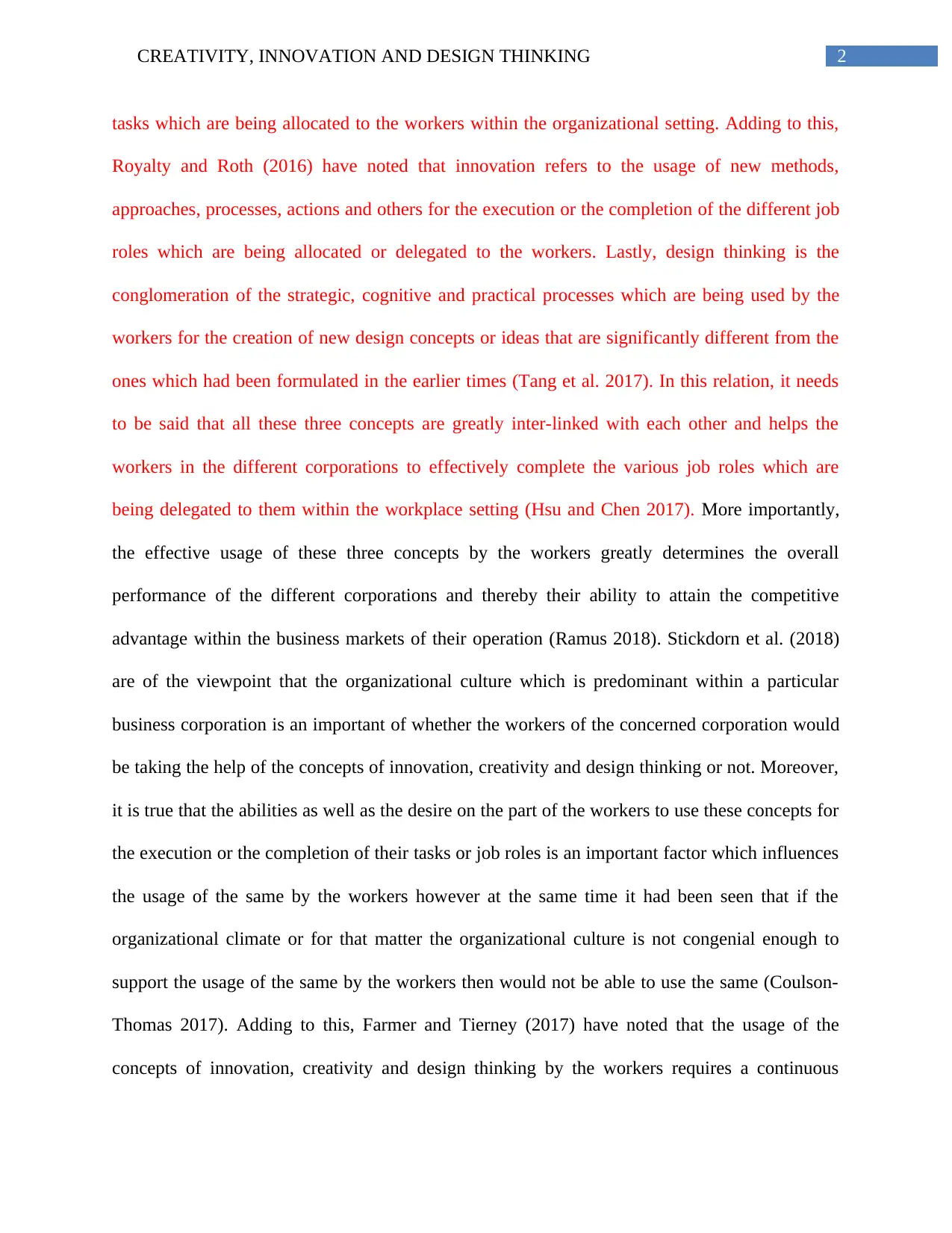
2CREATIVITY, INNOVATION AND DESIGN THINKING
tasks which are being allocated to the workers within the organizational setting. Adding to this,
Royalty and Roth (2016) have noted that innovation refers to the usage of new methods,
approaches, processes, actions and others for the execution or the completion of the different job
roles which are being allocated or delegated to the workers. Lastly, design thinking is the
conglomeration of the strategic, cognitive and practical processes which are being used by the
workers for the creation of new design concepts or ideas that are significantly different from the
ones which had been formulated in the earlier times (Tang et al. 2017). In this relation, it needs
to be said that all these three concepts are greatly inter-linked with each other and helps the
workers in the different corporations to effectively complete the various job roles which are
being delegated to them within the workplace setting (Hsu and Chen 2017). More importantly,
the effective usage of these three concepts by the workers greatly determines the overall
performance of the different corporations and thereby their ability to attain the competitive
advantage within the business markets of their operation (Ramus 2018). Stickdorn et al. (2018)
are of the viewpoint that the organizational culture which is predominant within a particular
business corporation is an important of whether the workers of the concerned corporation would
be taking the help of the concepts of innovation, creativity and design thinking or not. Moreover,
it is true that the abilities as well as the desire on the part of the workers to use these concepts for
the execution or the completion of their tasks or job roles is an important factor which influences
the usage of the same by the workers however at the same time it had been seen that if the
organizational climate or for that matter the organizational culture is not congenial enough to
support the usage of the same by the workers then would not be able to use the same (Coulson-
Thomas 2017). Adding to this, Farmer and Tierney (2017) have noted that the usage of the
concepts of innovation, creativity and design thinking by the workers requires a continuous
tasks which are being allocated to the workers within the organizational setting. Adding to this,
Royalty and Roth (2016) have noted that innovation refers to the usage of new methods,
approaches, processes, actions and others for the execution or the completion of the different job
roles which are being allocated or delegated to the workers. Lastly, design thinking is the
conglomeration of the strategic, cognitive and practical processes which are being used by the
workers for the creation of new design concepts or ideas that are significantly different from the
ones which had been formulated in the earlier times (Tang et al. 2017). In this relation, it needs
to be said that all these three concepts are greatly inter-linked with each other and helps the
workers in the different corporations to effectively complete the various job roles which are
being delegated to them within the workplace setting (Hsu and Chen 2017). More importantly,
the effective usage of these three concepts by the workers greatly determines the overall
performance of the different corporations and thereby their ability to attain the competitive
advantage within the business markets of their operation (Ramus 2018). Stickdorn et al. (2018)
are of the viewpoint that the organizational culture which is predominant within a particular
business corporation is an important of whether the workers of the concerned corporation would
be taking the help of the concepts of innovation, creativity and design thinking or not. Moreover,
it is true that the abilities as well as the desire on the part of the workers to use these concepts for
the execution or the completion of their tasks or job roles is an important factor which influences
the usage of the same by the workers however at the same time it had been seen that if the
organizational climate or for that matter the organizational culture is not congenial enough to
support the usage of the same by the workers then would not be able to use the same (Coulson-
Thomas 2017). Adding to this, Farmer and Tierney (2017) have noted that the usage of the
concepts of innovation, creativity and design thinking by the workers requires a continuous
⊘ This is a preview!⊘
Do you want full access?
Subscribe today to unlock all pages.

Trusted by 1+ million students worldwide
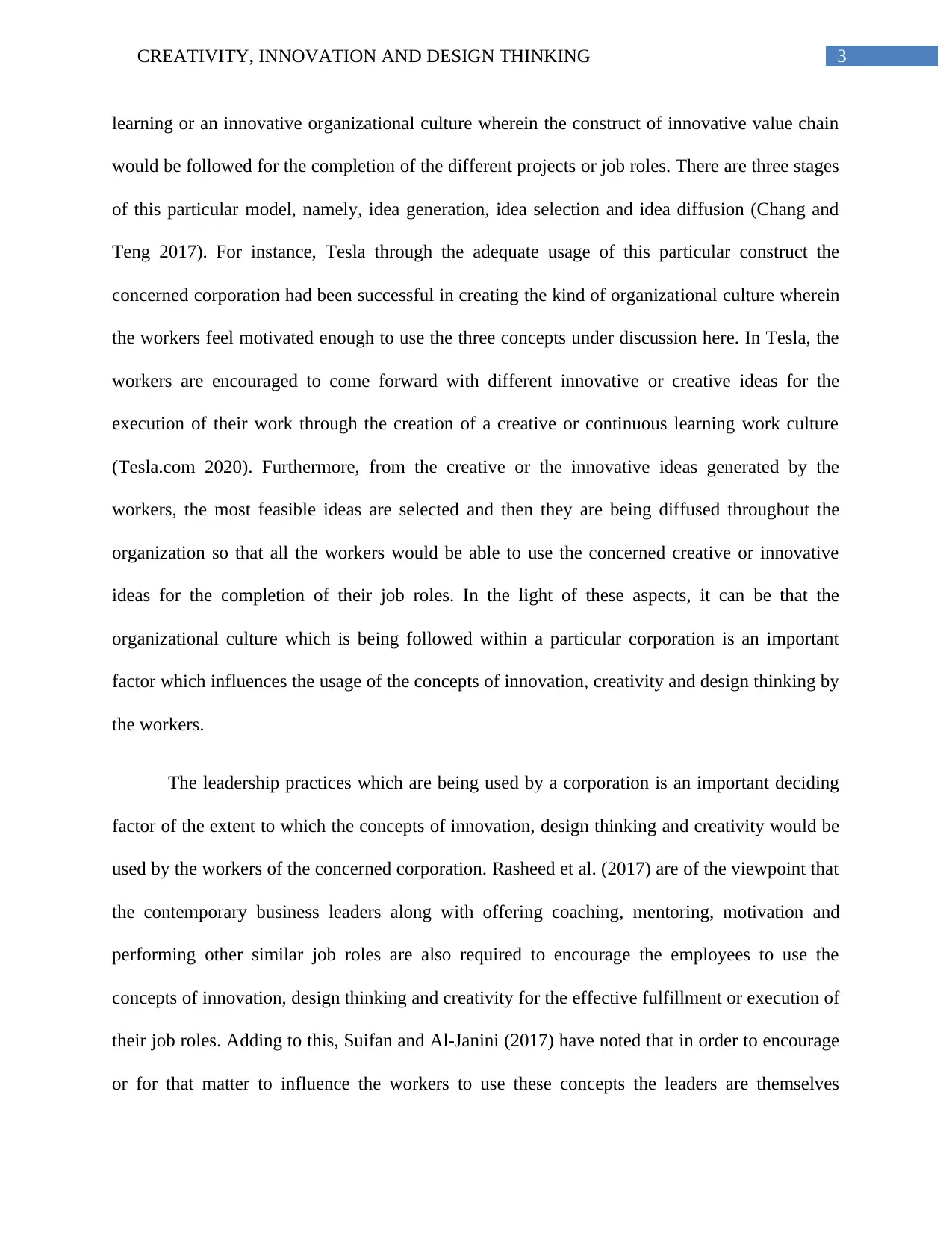
3CREATIVITY, INNOVATION AND DESIGN THINKING
learning or an innovative organizational culture wherein the construct of innovative value chain
would be followed for the completion of the different projects or job roles. There are three stages
of this particular model, namely, idea generation, idea selection and idea diffusion (Chang and
Teng 2017). For instance, Tesla through the adequate usage of this particular construct the
concerned corporation had been successful in creating the kind of organizational culture wherein
the workers feel motivated enough to use the three concepts under discussion here. In Tesla, the
workers are encouraged to come forward with different innovative or creative ideas for the
execution of their work through the creation of a creative or continuous learning work culture
(Tesla.com 2020). Furthermore, from the creative or the innovative ideas generated by the
workers, the most feasible ideas are selected and then they are being diffused throughout the
organization so that all the workers would be able to use the concerned creative or innovative
ideas for the completion of their job roles. In the light of these aspects, it can be that the
organizational culture which is being followed within a particular corporation is an important
factor which influences the usage of the concepts of innovation, creativity and design thinking by
the workers.
The leadership practices which are being used by a corporation is an important deciding
factor of the extent to which the concepts of innovation, design thinking and creativity would be
used by the workers of the concerned corporation. Rasheed et al. (2017) are of the viewpoint that
the contemporary business leaders along with offering coaching, mentoring, motivation and
performing other similar job roles are also required to encourage the employees to use the
concepts of innovation, design thinking and creativity for the effective fulfillment or execution of
their job roles. Adding to this, Suifan and Al-Janini (2017) have noted that in order to encourage
or for that matter to influence the workers to use these concepts the leaders are themselves
learning or an innovative organizational culture wherein the construct of innovative value chain
would be followed for the completion of the different projects or job roles. There are three stages
of this particular model, namely, idea generation, idea selection and idea diffusion (Chang and
Teng 2017). For instance, Tesla through the adequate usage of this particular construct the
concerned corporation had been successful in creating the kind of organizational culture wherein
the workers feel motivated enough to use the three concepts under discussion here. In Tesla, the
workers are encouraged to come forward with different innovative or creative ideas for the
execution of their work through the creation of a creative or continuous learning work culture
(Tesla.com 2020). Furthermore, from the creative or the innovative ideas generated by the
workers, the most feasible ideas are selected and then they are being diffused throughout the
organization so that all the workers would be able to use the concerned creative or innovative
ideas for the completion of their job roles. In the light of these aspects, it can be that the
organizational culture which is being followed within a particular corporation is an important
factor which influences the usage of the concepts of innovation, creativity and design thinking by
the workers.
The leadership practices which are being used by a corporation is an important deciding
factor of the extent to which the concepts of innovation, design thinking and creativity would be
used by the workers of the concerned corporation. Rasheed et al. (2017) are of the viewpoint that
the contemporary business leaders along with offering coaching, mentoring, motivation and
performing other similar job roles are also required to encourage the employees to use the
concepts of innovation, design thinking and creativity for the effective fulfillment or execution of
their job roles. Adding to this, Suifan and Al-Janini (2017) have noted that in order to encourage
or for that matter to influence the workers to use these concepts the leaders are themselves
Paraphrase This Document
Need a fresh take? Get an instant paraphrase of this document with our AI Paraphraser
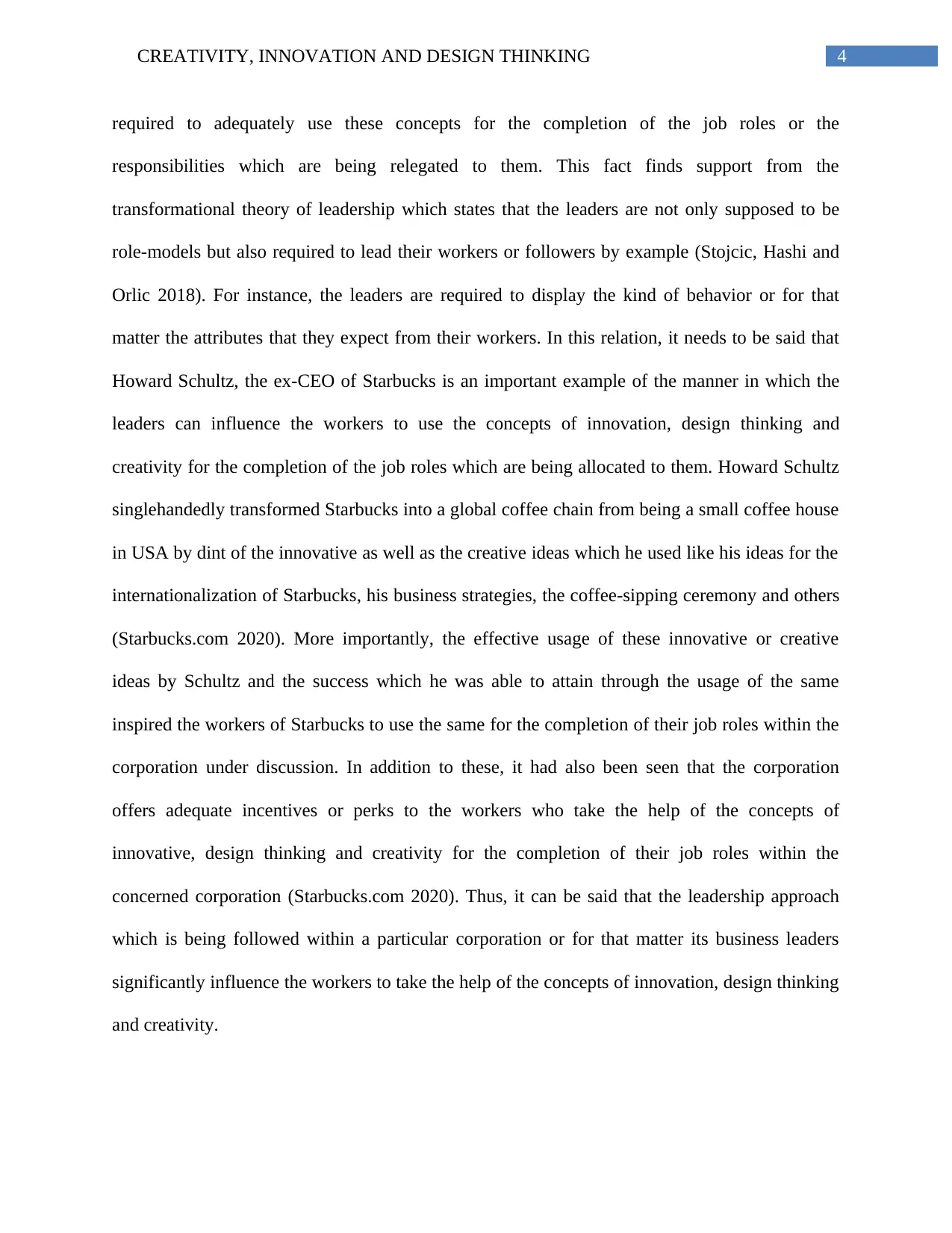
4CREATIVITY, INNOVATION AND DESIGN THINKING
required to adequately use these concepts for the completion of the job roles or the
responsibilities which are being relegated to them. This fact finds support from the
transformational theory of leadership which states that the leaders are not only supposed to be
role-models but also required to lead their workers or followers by example (Stojcic, Hashi and
Orlic 2018). For instance, the leaders are required to display the kind of behavior or for that
matter the attributes that they expect from their workers. In this relation, it needs to be said that
Howard Schultz, the ex-CEO of Starbucks is an important example of the manner in which the
leaders can influence the workers to use the concepts of innovation, design thinking and
creativity for the completion of the job roles which are being allocated to them. Howard Schultz
singlehandedly transformed Starbucks into a global coffee chain from being a small coffee house
in USA by dint of the innovative as well as the creative ideas which he used like his ideas for the
internationalization of Starbucks, his business strategies, the coffee-sipping ceremony and others
(Starbucks.com 2020). More importantly, the effective usage of these innovative or creative
ideas by Schultz and the success which he was able to attain through the usage of the same
inspired the workers of Starbucks to use the same for the completion of their job roles within the
corporation under discussion. In addition to these, it had also been seen that the corporation
offers adequate incentives or perks to the workers who take the help of the concepts of
innovative, design thinking and creativity for the completion of their job roles within the
concerned corporation (Starbucks.com 2020). Thus, it can be said that the leadership approach
which is being followed within a particular corporation or for that matter its business leaders
significantly influence the workers to take the help of the concepts of innovation, design thinking
and creativity.
required to adequately use these concepts for the completion of the job roles or the
responsibilities which are being relegated to them. This fact finds support from the
transformational theory of leadership which states that the leaders are not only supposed to be
role-models but also required to lead their workers or followers by example (Stojcic, Hashi and
Orlic 2018). For instance, the leaders are required to display the kind of behavior or for that
matter the attributes that they expect from their workers. In this relation, it needs to be said that
Howard Schultz, the ex-CEO of Starbucks is an important example of the manner in which the
leaders can influence the workers to use the concepts of innovation, design thinking and
creativity for the completion of the job roles which are being allocated to them. Howard Schultz
singlehandedly transformed Starbucks into a global coffee chain from being a small coffee house
in USA by dint of the innovative as well as the creative ideas which he used like his ideas for the
internationalization of Starbucks, his business strategies, the coffee-sipping ceremony and others
(Starbucks.com 2020). More importantly, the effective usage of these innovative or creative
ideas by Schultz and the success which he was able to attain through the usage of the same
inspired the workers of Starbucks to use the same for the completion of their job roles within the
corporation under discussion. In addition to these, it had also been seen that the corporation
offers adequate incentives or perks to the workers who take the help of the concepts of
innovative, design thinking and creativity for the completion of their job roles within the
concerned corporation (Starbucks.com 2020). Thus, it can be said that the leadership approach
which is being followed within a particular corporation or for that matter its business leaders
significantly influence the workers to take the help of the concepts of innovation, design thinking
and creativity.
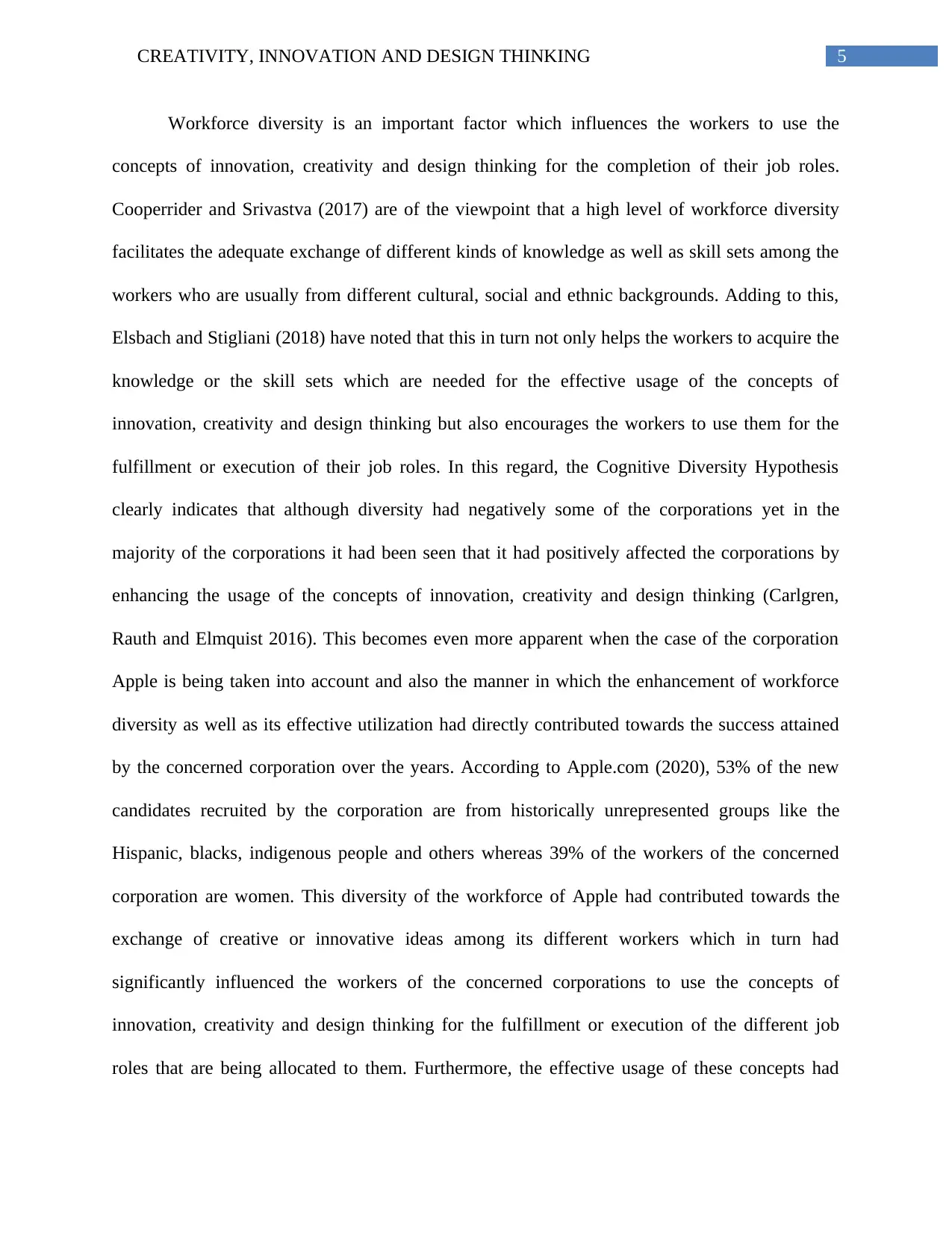
5CREATIVITY, INNOVATION AND DESIGN THINKING
Workforce diversity is an important factor which influences the workers to use the
concepts of innovation, creativity and design thinking for the completion of their job roles.
Cooperrider and Srivastva (2017) are of the viewpoint that a high level of workforce diversity
facilitates the adequate exchange of different kinds of knowledge as well as skill sets among the
workers who are usually from different cultural, social and ethnic backgrounds. Adding to this,
Elsbach and Stigliani (2018) have noted that this in turn not only helps the workers to acquire the
knowledge or the skill sets which are needed for the effective usage of the concepts of
innovation, creativity and design thinking but also encourages the workers to use them for the
fulfillment or execution of their job roles. In this regard, the Cognitive Diversity Hypothesis
clearly indicates that although diversity had negatively some of the corporations yet in the
majority of the corporations it had been seen that it had positively affected the corporations by
enhancing the usage of the concepts of innovation, creativity and design thinking (Carlgren,
Rauth and Elmquist 2016). This becomes even more apparent when the case of the corporation
Apple is being taken into account and also the manner in which the enhancement of workforce
diversity as well as its effective utilization had directly contributed towards the success attained
by the concerned corporation over the years. According to Apple.com (2020), 53% of the new
candidates recruited by the corporation are from historically unrepresented groups like the
Hispanic, blacks, indigenous people and others whereas 39% of the workers of the concerned
corporation are women. This diversity of the workforce of Apple had contributed towards the
exchange of creative or innovative ideas among its different workers which in turn had
significantly influenced the workers of the concerned corporations to use the concepts of
innovation, creativity and design thinking for the fulfillment or execution of the different job
roles that are being allocated to them. Furthermore, the effective usage of these concepts had
Workforce diversity is an important factor which influences the workers to use the
concepts of innovation, creativity and design thinking for the completion of their job roles.
Cooperrider and Srivastva (2017) are of the viewpoint that a high level of workforce diversity
facilitates the adequate exchange of different kinds of knowledge as well as skill sets among the
workers who are usually from different cultural, social and ethnic backgrounds. Adding to this,
Elsbach and Stigliani (2018) have noted that this in turn not only helps the workers to acquire the
knowledge or the skill sets which are needed for the effective usage of the concepts of
innovation, creativity and design thinking but also encourages the workers to use them for the
fulfillment or execution of their job roles. In this regard, the Cognitive Diversity Hypothesis
clearly indicates that although diversity had negatively some of the corporations yet in the
majority of the corporations it had been seen that it had positively affected the corporations by
enhancing the usage of the concepts of innovation, creativity and design thinking (Carlgren,
Rauth and Elmquist 2016). This becomes even more apparent when the case of the corporation
Apple is being taken into account and also the manner in which the enhancement of workforce
diversity as well as its effective utilization had directly contributed towards the success attained
by the concerned corporation over the years. According to Apple.com (2020), 53% of the new
candidates recruited by the corporation are from historically unrepresented groups like the
Hispanic, blacks, indigenous people and others whereas 39% of the workers of the concerned
corporation are women. This diversity of the workforce of Apple had contributed towards the
exchange of creative or innovative ideas among its different workers which in turn had
significantly influenced the workers of the concerned corporations to use the concepts of
innovation, creativity and design thinking for the fulfillment or execution of the different job
roles that are being allocated to them. Furthermore, the effective usage of these concepts had
⊘ This is a preview!⊘
Do you want full access?
Subscribe today to unlock all pages.

Trusted by 1+ million students worldwide
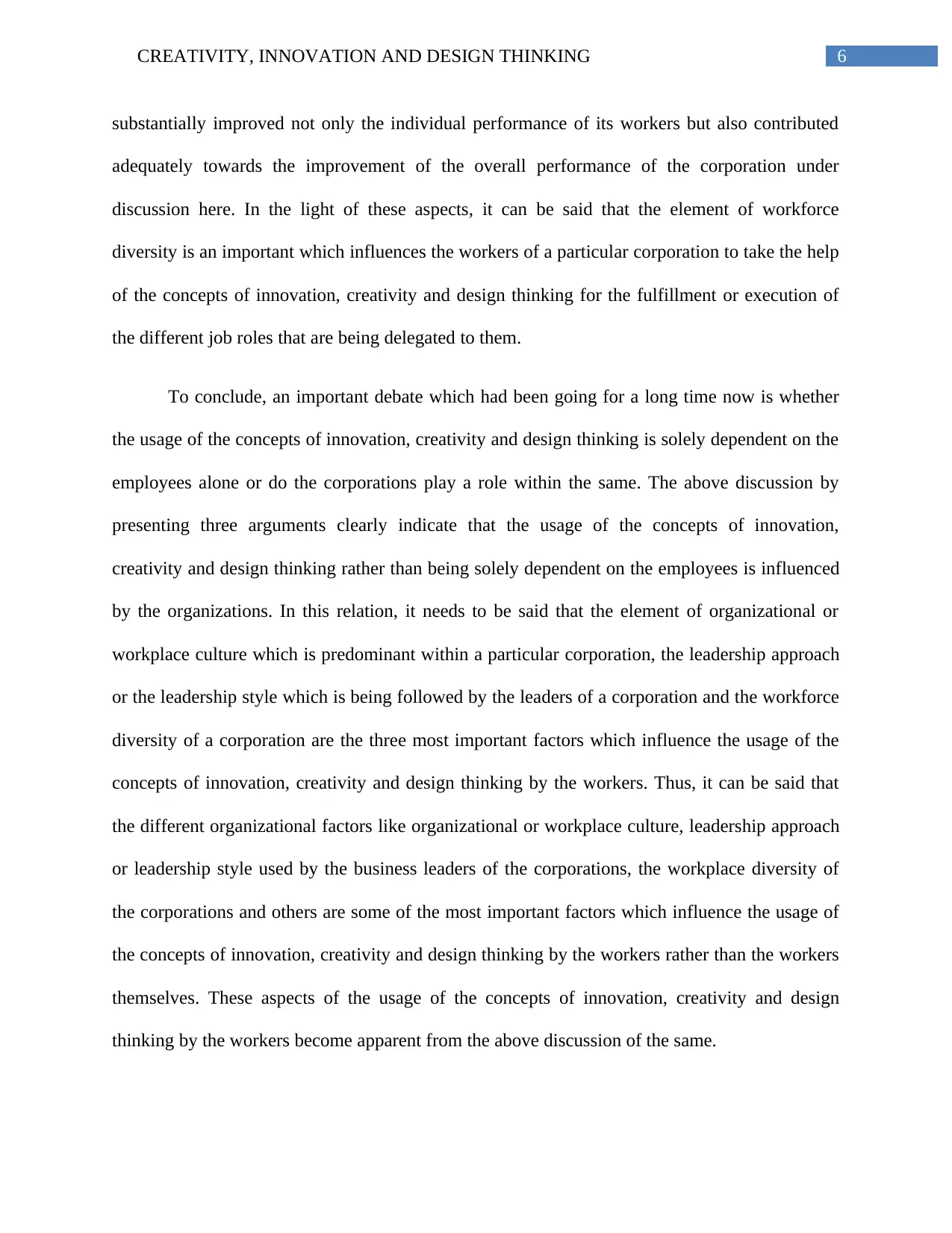
6CREATIVITY, INNOVATION AND DESIGN THINKING
substantially improved not only the individual performance of its workers but also contributed
adequately towards the improvement of the overall performance of the corporation under
discussion here. In the light of these aspects, it can be said that the element of workforce
diversity is an important which influences the workers of a particular corporation to take the help
of the concepts of innovation, creativity and design thinking for the fulfillment or execution of
the different job roles that are being delegated to them.
To conclude, an important debate which had been going for a long time now is whether
the usage of the concepts of innovation, creativity and design thinking is solely dependent on the
employees alone or do the corporations play a role within the same. The above discussion by
presenting three arguments clearly indicate that the usage of the concepts of innovation,
creativity and design thinking rather than being solely dependent on the employees is influenced
by the organizations. In this relation, it needs to be said that the element of organizational or
workplace culture which is predominant within a particular corporation, the leadership approach
or the leadership style which is being followed by the leaders of a corporation and the workforce
diversity of a corporation are the three most important factors which influence the usage of the
concepts of innovation, creativity and design thinking by the workers. Thus, it can be said that
the different organizational factors like organizational or workplace culture, leadership approach
or leadership style used by the business leaders of the corporations, the workplace diversity of
the corporations and others are some of the most important factors which influence the usage of
the concepts of innovation, creativity and design thinking by the workers rather than the workers
themselves. These aspects of the usage of the concepts of innovation, creativity and design
thinking by the workers become apparent from the above discussion of the same.
substantially improved not only the individual performance of its workers but also contributed
adequately towards the improvement of the overall performance of the corporation under
discussion here. In the light of these aspects, it can be said that the element of workforce
diversity is an important which influences the workers of a particular corporation to take the help
of the concepts of innovation, creativity and design thinking for the fulfillment or execution of
the different job roles that are being delegated to them.
To conclude, an important debate which had been going for a long time now is whether
the usage of the concepts of innovation, creativity and design thinking is solely dependent on the
employees alone or do the corporations play a role within the same. The above discussion by
presenting three arguments clearly indicate that the usage of the concepts of innovation,
creativity and design thinking rather than being solely dependent on the employees is influenced
by the organizations. In this relation, it needs to be said that the element of organizational or
workplace culture which is predominant within a particular corporation, the leadership approach
or the leadership style which is being followed by the leaders of a corporation and the workforce
diversity of a corporation are the three most important factors which influence the usage of the
concepts of innovation, creativity and design thinking by the workers. Thus, it can be said that
the different organizational factors like organizational or workplace culture, leadership approach
or leadership style used by the business leaders of the corporations, the workplace diversity of
the corporations and others are some of the most important factors which influence the usage of
the concepts of innovation, creativity and design thinking by the workers rather than the workers
themselves. These aspects of the usage of the concepts of innovation, creativity and design
thinking by the workers become apparent from the above discussion of the same.
Paraphrase This Document
Need a fresh take? Get an instant paraphrase of this document with our AI Paraphraser
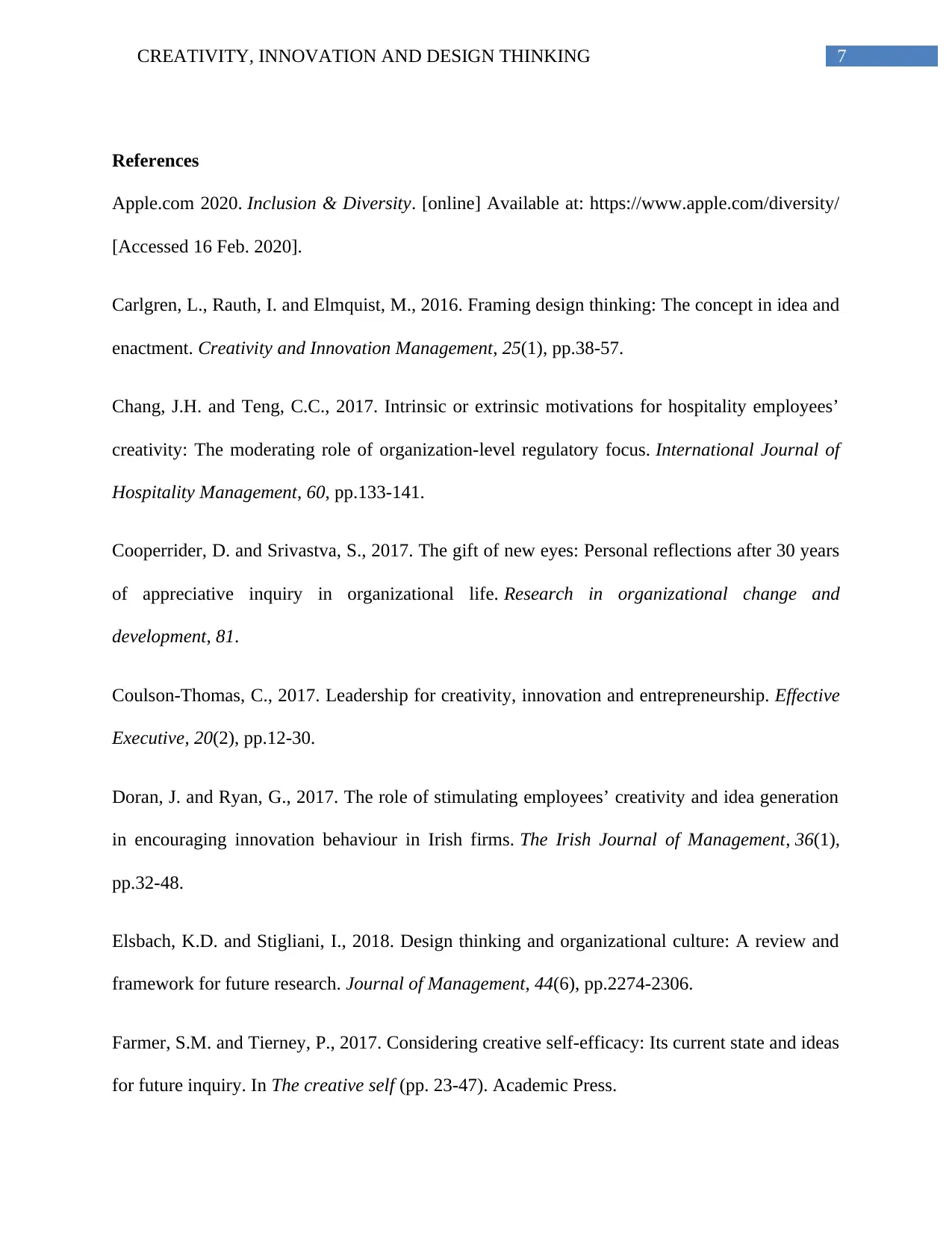
7CREATIVITY, INNOVATION AND DESIGN THINKING
References
Apple.com 2020. Inclusion & Diversity. [online] Available at: https://www.apple.com/diversity/
[Accessed 16 Feb. 2020].
Carlgren, L., Rauth, I. and Elmquist, M., 2016. Framing design thinking: The concept in idea and
enactment. Creativity and Innovation Management, 25(1), pp.38-57.
Chang, J.H. and Teng, C.C., 2017. Intrinsic or extrinsic motivations for hospitality employees’
creativity: The moderating role of organization-level regulatory focus. International Journal of
Hospitality Management, 60, pp.133-141.
Cooperrider, D. and Srivastva, S., 2017. The gift of new eyes: Personal reflections after 30 years
of appreciative inquiry in organizational life. Research in organizational change and
development, 81.
Coulson-Thomas, C., 2017. Leadership for creativity, innovation and entrepreneurship. Effective
Executive, 20(2), pp.12-30.
Doran, J. and Ryan, G., 2017. The role of stimulating employees’ creativity and idea generation
in encouraging innovation behaviour in Irish firms. The Irish Journal of Management, 36(1),
pp.32-48.
Elsbach, K.D. and Stigliani, I., 2018. Design thinking and organizational culture: A review and
framework for future research. Journal of Management, 44(6), pp.2274-2306.
Farmer, S.M. and Tierney, P., 2017. Considering creative self-efficacy: Its current state and ideas
for future inquiry. In The creative self (pp. 23-47). Academic Press.
References
Apple.com 2020. Inclusion & Diversity. [online] Available at: https://www.apple.com/diversity/
[Accessed 16 Feb. 2020].
Carlgren, L., Rauth, I. and Elmquist, M., 2016. Framing design thinking: The concept in idea and
enactment. Creativity and Innovation Management, 25(1), pp.38-57.
Chang, J.H. and Teng, C.C., 2017. Intrinsic or extrinsic motivations for hospitality employees’
creativity: The moderating role of organization-level regulatory focus. International Journal of
Hospitality Management, 60, pp.133-141.
Cooperrider, D. and Srivastva, S., 2017. The gift of new eyes: Personal reflections after 30 years
of appreciative inquiry in organizational life. Research in organizational change and
development, 81.
Coulson-Thomas, C., 2017. Leadership for creativity, innovation and entrepreneurship. Effective
Executive, 20(2), pp.12-30.
Doran, J. and Ryan, G., 2017. The role of stimulating employees’ creativity and idea generation
in encouraging innovation behaviour in Irish firms. The Irish Journal of Management, 36(1),
pp.32-48.
Elsbach, K.D. and Stigliani, I., 2018. Design thinking and organizational culture: A review and
framework for future research. Journal of Management, 44(6), pp.2274-2306.
Farmer, S.M. and Tierney, P., 2017. Considering creative self-efficacy: Its current state and ideas
for future inquiry. In The creative self (pp. 23-47). Academic Press.
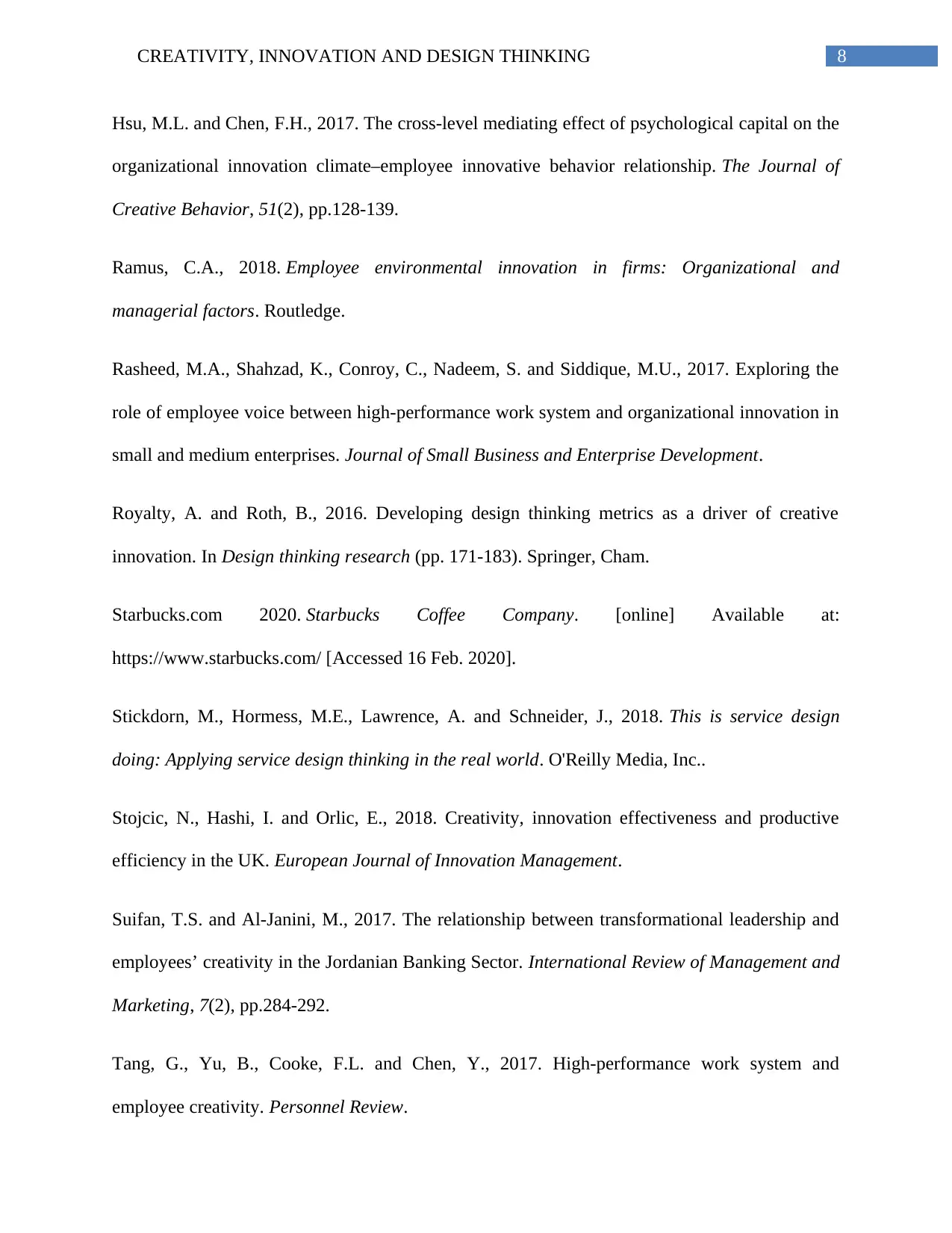
8CREATIVITY, INNOVATION AND DESIGN THINKING
Hsu, M.L. and Chen, F.H., 2017. The cross‐level mediating effect of psychological capital on the
organizational innovation climate–employee innovative behavior relationship. The Journal of
Creative Behavior, 51(2), pp.128-139.
Ramus, C.A., 2018. Employee environmental innovation in firms: Organizational and
managerial factors. Routledge.
Rasheed, M.A., Shahzad, K., Conroy, C., Nadeem, S. and Siddique, M.U., 2017. Exploring the
role of employee voice between high-performance work system and organizational innovation in
small and medium enterprises. Journal of Small Business and Enterprise Development.
Royalty, A. and Roth, B., 2016. Developing design thinking metrics as a driver of creative
innovation. In Design thinking research (pp. 171-183). Springer, Cham.
Starbucks.com 2020. Starbucks Coffee Company. [online] Available at:
https://www.starbucks.com/ [Accessed 16 Feb. 2020].
Stickdorn, M., Hormess, M.E., Lawrence, A. and Schneider, J., 2018. This is service design
doing: Applying service design thinking in the real world. O'Reilly Media, Inc..
Stojcic, N., Hashi, I. and Orlic, E., 2018. Creativity, innovation effectiveness and productive
efficiency in the UK. European Journal of Innovation Management.
Suifan, T.S. and Al-Janini, M., 2017. The relationship between transformational leadership and
employees’ creativity in the Jordanian Banking Sector. International Review of Management and
Marketing, 7(2), pp.284-292.
Tang, G., Yu, B., Cooke, F.L. and Chen, Y., 2017. High-performance work system and
employee creativity. Personnel Review.
Hsu, M.L. and Chen, F.H., 2017. The cross‐level mediating effect of psychological capital on the
organizational innovation climate–employee innovative behavior relationship. The Journal of
Creative Behavior, 51(2), pp.128-139.
Ramus, C.A., 2018. Employee environmental innovation in firms: Organizational and
managerial factors. Routledge.
Rasheed, M.A., Shahzad, K., Conroy, C., Nadeem, S. and Siddique, M.U., 2017. Exploring the
role of employee voice between high-performance work system and organizational innovation in
small and medium enterprises. Journal of Small Business and Enterprise Development.
Royalty, A. and Roth, B., 2016. Developing design thinking metrics as a driver of creative
innovation. In Design thinking research (pp. 171-183). Springer, Cham.
Starbucks.com 2020. Starbucks Coffee Company. [online] Available at:
https://www.starbucks.com/ [Accessed 16 Feb. 2020].
Stickdorn, M., Hormess, M.E., Lawrence, A. and Schneider, J., 2018. This is service design
doing: Applying service design thinking in the real world. O'Reilly Media, Inc..
Stojcic, N., Hashi, I. and Orlic, E., 2018. Creativity, innovation effectiveness and productive
efficiency in the UK. European Journal of Innovation Management.
Suifan, T.S. and Al-Janini, M., 2017. The relationship between transformational leadership and
employees’ creativity in the Jordanian Banking Sector. International Review of Management and
Marketing, 7(2), pp.284-292.
Tang, G., Yu, B., Cooke, F.L. and Chen, Y., 2017. High-performance work system and
employee creativity. Personnel Review.
⊘ This is a preview!⊘
Do you want full access?
Subscribe today to unlock all pages.

Trusted by 1+ million students worldwide
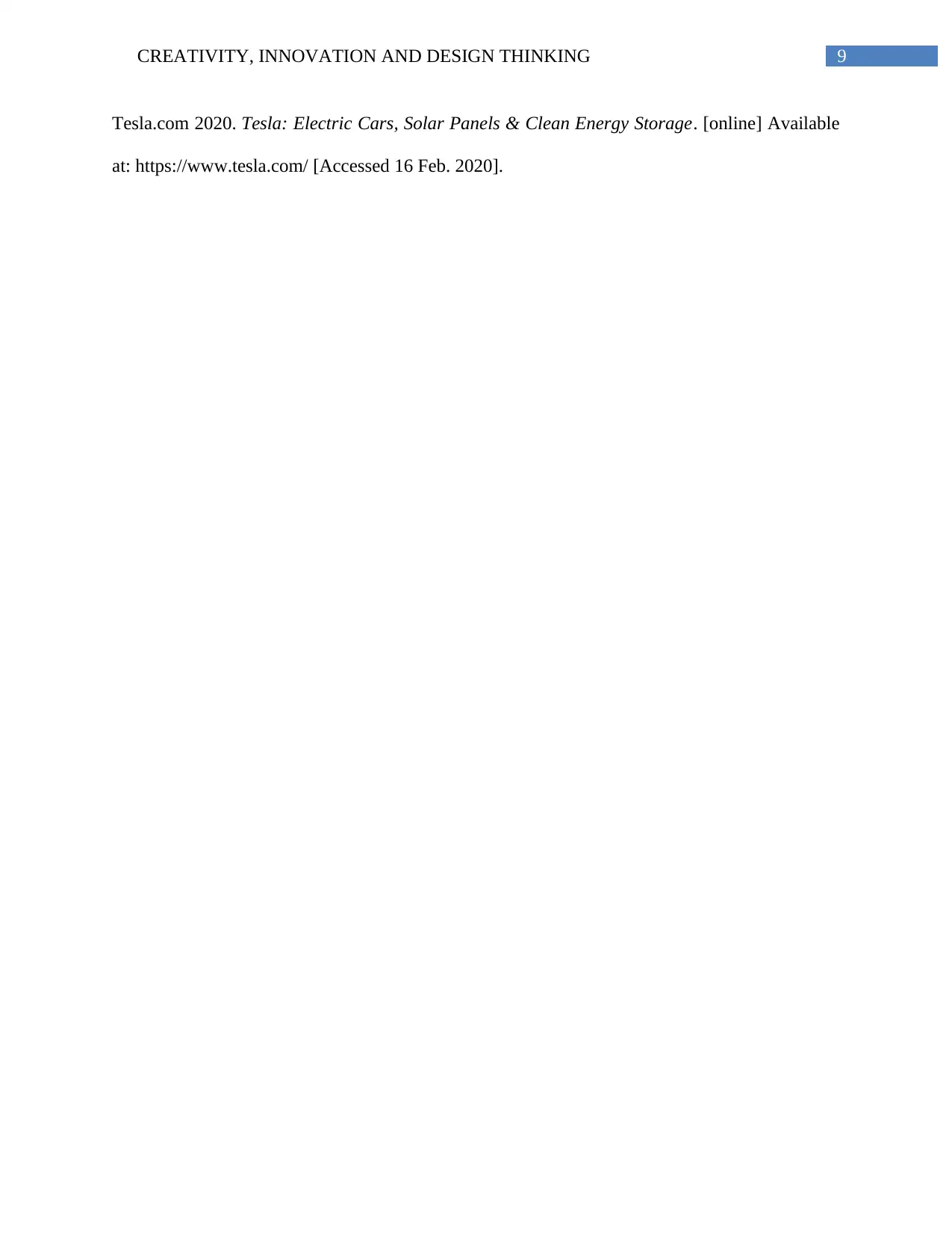
9CREATIVITY, INNOVATION AND DESIGN THINKING
Tesla.com 2020. Tesla: Electric Cars, Solar Panels & Clean Energy Storage. [online] Available
at: https://www.tesla.com/ [Accessed 16 Feb. 2020].
Tesla.com 2020. Tesla: Electric Cars, Solar Panels & Clean Energy Storage. [online] Available
at: https://www.tesla.com/ [Accessed 16 Feb. 2020].
1 out of 10
Related Documents
Your All-in-One AI-Powered Toolkit for Academic Success.
+13062052269
info@desklib.com
Available 24*7 on WhatsApp / Email
![[object Object]](/_next/static/media/star-bottom.7253800d.svg)
Unlock your academic potential
Copyright © 2020–2025 A2Z Services. All Rights Reserved. Developed and managed by ZUCOL.





